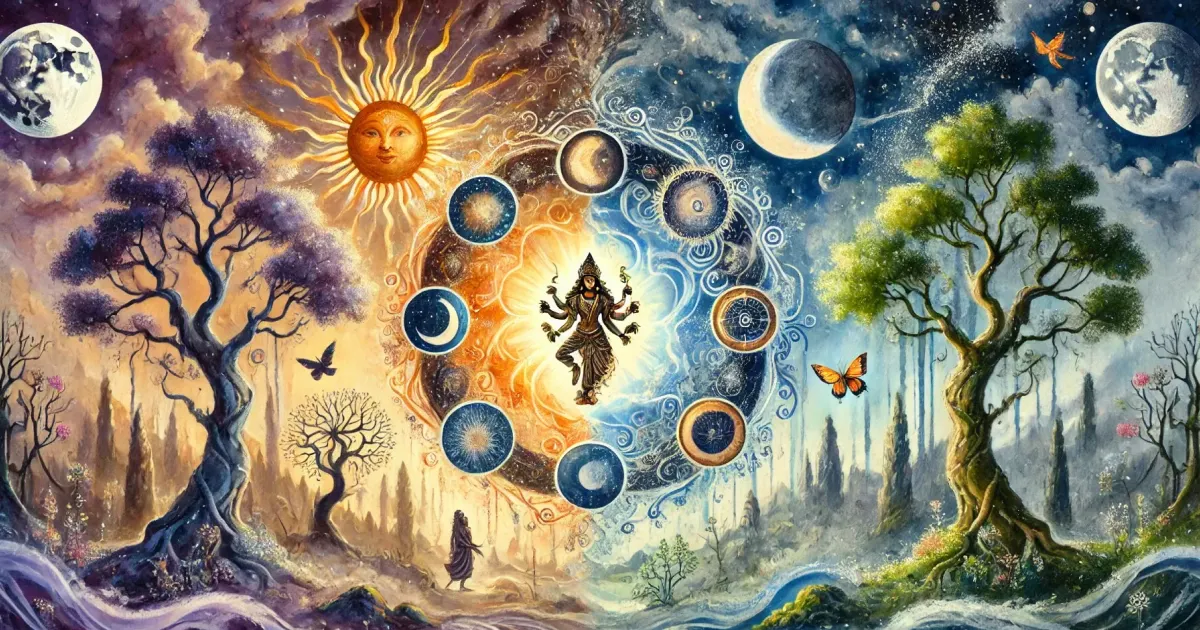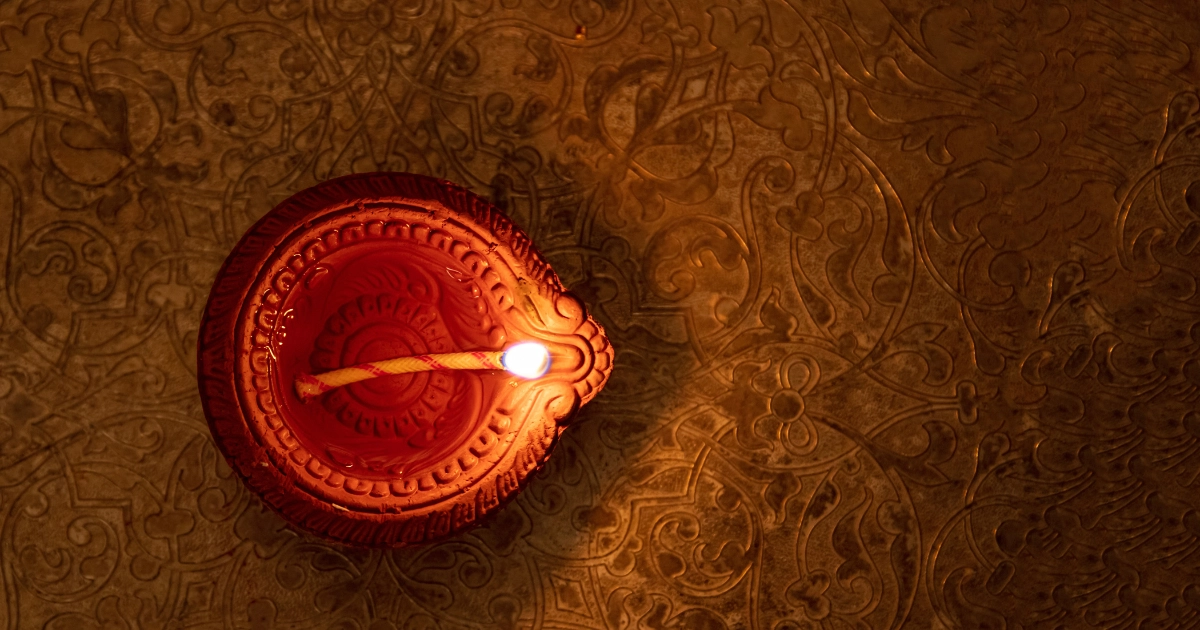A new day appears and disappears into the night
The night disappears only to appear as the new night
The sun doesn’t glow with the same intensity
nor does the moon with the same luminosity
Yet nature responds to each day and night in uniformity
At the stroke of the dawn
all birds leave their nest
and by the hour of dusk they find their path back home
This same cyclical rhythm adorns the seasons, rtu
adorns years - samvatsara, yuga, kalpa, manvantara
- RamachandraCosmic vision of time, Kāla, as seen by the ancient seers, deftly marries the change and uniformity. Time moves relentlessly towards the dissolution of creation. In doing so, it is only sowing the seeds for the next creation.
Quote from Sri Ramakrishna KathamritaQuestion: Describe to us, sir, in how many ways Kāli, the Divine Mother sports in this world.
Sri Ramakrishna Paramahansa:
Oh, She plays in different ways. It is She alone who is known as Mahākāli, Nitya Kāli, Smaśāna Kāli, Rakṣā Kāli and Śyāma Kāli. Mahākāli and Nitya Kāli are mentioned in Tantra philosophy. When there was neither the creation, nor the sun, the moon, the planets, and the earth, and when darkness was enveloped in darkness, then the Mother, the formless One, Mahā Kāli, the Great Power, was one with Mahā Kāla, the Absolute.
After the destruction of the universe, at the end of the great cycle, the Divine Mother garners the seeds for the next creation. She is like an elderly mistress of the house, who has a hotchpotch pot in which she keeps different articles for household use (laughing).
After the destruction of the universe, my Divine Mother, the Embodiment of Brahman, gathers together seeds for the next creation. After the creation the Primal Power dwells in the Universe itself. She brings forth this phenomenal world and then pervades it.
Myth is located in sacred time and space. For ages, the mythic perspective of humans whose lives remain imbued with religiosity has considered time to adorn cyclical nature. Not just India , but everywhere, in every single point of this circular globe. Even when humans didn't know whether the earth was flat or not. Time forever, from a perspective of religious experience, appeared cyclical.
Cyclical means the repeated occurrence of the event. That means creation, which is the primordial event, has not just occurred once in some remote past. Instead, it is a repeated act. This doesn't make sense to the modern mind, which struggles to exist in intuitive and mundane planes of consciousness simultaneously.
For example, we are not celebrating Onam in memory of Vamana vanquishing Bali in some remote timeline. It occurs once again, here and now, so we are celebrating that victory, Now.
We are celebrating Śrī Kṛṣṇa Janmāṣṭhamī as the advent of Śrī Kṛṣṇa, now, not his 3754th birthday. We choose to put those little superlatively beautiful infant footprints with so much love. Our hearts experience immeasurable joy just by looking at them.
We are not celebrating his growth in a linear time scale, we are celebrating this occurrence. He takes birth again and again. He will continue to infuse his influence on this earthly plane, every year. Every year he uplifts us by His arrival. After His arrival, he continues to enrich us through his play. Our rishis handed over the most sophisticated ritual manual, which helps us connect our now to both past and future. To lose this perspective and contextualize our sacred events in terms of linearity of time and historicise them at the peril of losing the Divine essence, leads to de-sacralization, i.e., sacrificing the power of Sacred on the altar of the mundane.
The process of de-sacralization of time occurred in the theosphere, for the first time, when religion chose to do away with the cyclical nature of time and mutated it into a linear one.
Mircea Eliade in his seminal work The Sacred and The Profane discussed at length about the sacrality of time across diverse cultures. Here, he clearly indicates how Abrahamic religions played pivotal role in what he terms the valorisation of historical time:
Compared with the archaic and palaoe-oriental religions, as well as the mythic-philosophical conceptions of the eternal return, as they were elaborated in India and Greece, Judaism presents an innovation of the first importance. For Judaism, time has a beginning and will have an end. The idea of cyclic time is left behind. Yahweh no longer manifests himself in cosmic time (like gods of other religions ) but in a historical time, which is irreversible.
Eliade further expounds about how Christianity contributed to the championing of this idea:
Christianity goes even further in valorising historical time. Since God was incarnated, that is, since he took on a historically conditioned human existence, history acquires the possibility of being sanctified.
Christianity arrives, not at a philosophy but at a theology of history. For God’s interventions in history, and above all his incarnation in the historical person of Jesus Christ, have a transhistorical purpose - the Salvation of man.
Eliade addresses this phenomenon as theophany, i.e., the emergence of Divine purpose in an otherwise historical event. But from a perspective of Hindu world view this so-called innovation in terms of historicization of time was indeed a primer to what follows as de-sacralization of time in modernity. De-sacralization of time means emptying time of all religiosity. In Eliade’s own words -
Hegel takes over the Judaeo-Christian ideology and applies it to universal history in its totality: universal spirit continually manifests itself in historical events and manifests itself only in historical events. Thus the whole of history becomes a theophany: everything that happens in history had to happen as it did, because the universal spirit so willed it. The road is thus opened to the various forms of twentieth-century historicist philosophies.
This theological shift with regards to sacrality of time ushers in linear time that runs towards damnation without any further scope for reincarnation. Now the mythical time became a straight arrow vanishing into nothingness, conquests fully morphed into crusades. The Savior complex was hurled onto cultures, both physically and theologically. Those who do not subscribe to this idea of theological implications of history have to be saved from damnation either by conversion or annihilation.
When a modern mind looks back into historicity to declare that much violence has unfurled in the name of religion, one can confidently ascribe this theologizing of history as one of the primary factors.
Rationality that emerged as a consequence to suffocation caused by this theophany of history, felt it was meaningful to explore the truths of mute matter rather than subscribe to the notion of punitive God obsessed with countless do's and don'ts, waiting at the edge of time to pass his Judgment.
Once the modern philosophies emptied time of all sacredness, there was nothing left to revere in existence. All the progress that ensued erected a powerful world with the indomitable ambition of controlling nature. While in its dawn, progress surely looked promising, but by its noons, it too succumbed to human ignorance by birthing the unparalleled weapons of mass destruction ever ready to serve the crusades, about to deliver denouement of human existence.
Humans cannot thrive for too long in the environment sans meaning. But now it's difficult to return to the sacred. If one tries to step into the realms of the sacred, one invariably gets sucked into crusade zones. But continued examination of matter also seems to have reached the dead end of its reductionist view. There might be countless innovations to rectify many human maladies, but the meaning of life remains elusive, for it cannot be trapped in the confines of inert matter. Thus contemporary individuals are trapped in a state of limbo. Such a post-modern world is in search of meaning without any commitment to sacrality. Therefore ideologies usher in new strains of myth with myriad hues.
This mythic view is so genius that the emergence of de-sacralized cultures in post-modern times have instituted their own versions of celebrations, exactly using the same template. So we will celebrate every year, men's day, women's day, ants’ day , dogs’ day, not to forget special parades and marches. They all might look like flop shows now, especially when compared to our celebrations of traditional festivals, but soon they will outplay your traditional festivals in glitter and glamor.
For a few decades, children will straddle both worlds and eventually, traditional festivals will be wiped out. Because it is simply impossible for the human psyche to hold the paradox for too long. So, they will drift to the more dominant side. Before this transition happens, there will be a twilight zone in between, where traditional festivals and their sacrality will be thoroughly contaminated, so much so that one won't be able to remember their original fervor anymore. They will be festivals sans pure light and true color. Almost celebrating the gloom of meaninglessness.
So don't give up your celebration of the advent of zillion Gods, ancestral forces etc etc. Because we are not just celebrating some far, distant, indifferent past. Instead we are doing the impossible by holding the past, present and future in one heroic act of celebration.
In the darkest hours of collective human experience, celebration of these advents will be both redemptive and revolutionary. Not just the advents, celebration of every sacred event will prove to be an antithesis of de-sacralization. This is the very reason we see an influx of people from de-sacralized cultures into cultures where the sacred is still thriving and throbbing.
Shubh Deepavali.






